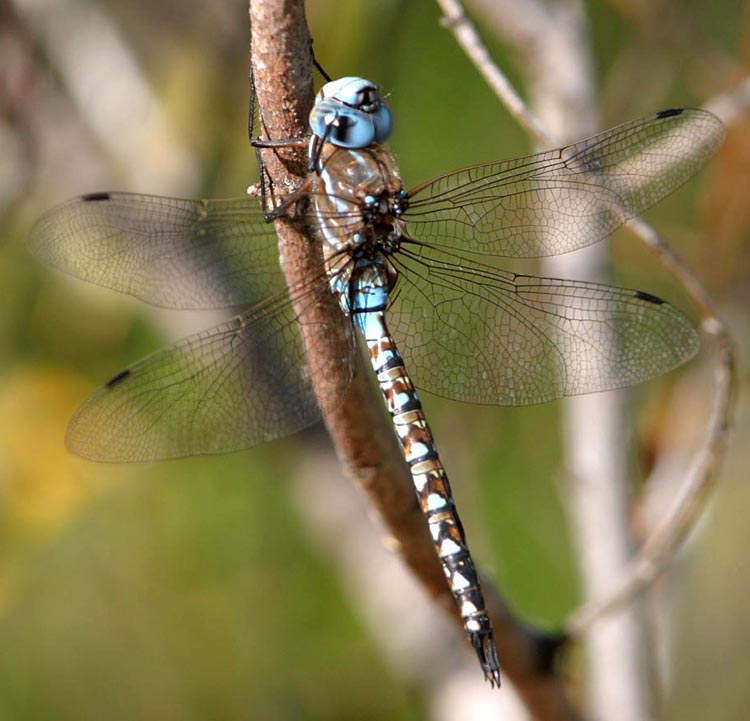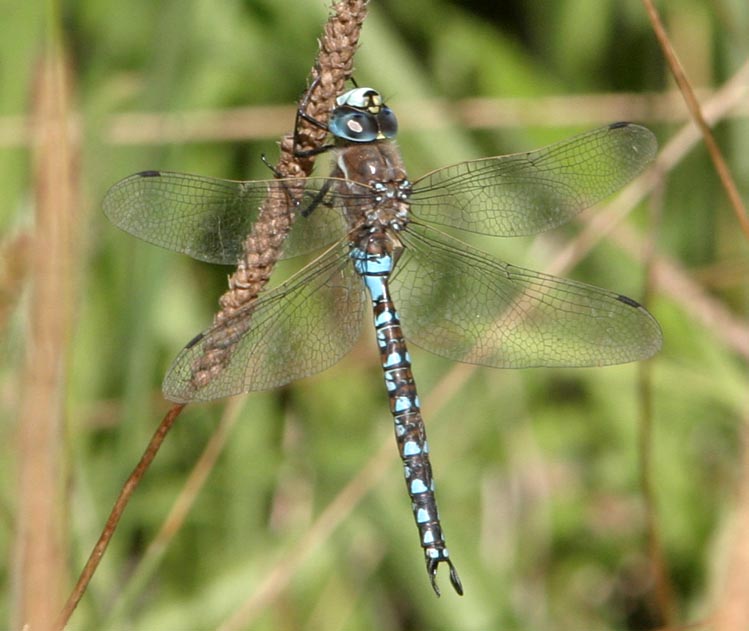|
page two-and-a-half
ODELLO ODES REPRISE
Those Darn Darners
|
|
On an
earlier page I posted a photo of Blue-eyed Darner Rhionaeschna
multicolor, taken at the Odello Lagoon, Carmel River mouth, Monterey
County; reposted below at somewhat larger size. Today I was reading Tim
Manolis's book (2003) and Kathy Biggs' useful
web site, trying to figure out how one would identify California Darner
Rhionaeschna
california which, according the map of Kathy's site and the checklist
on the U.Texas site, had never been recorded in Monterey County (MTY, to
use the standard bird observation abbreviation for the county). This is
despite the fact that Manolis (2003) shows it within range here, and despite
the fact it had been recorded in almost all the neighboring counties.

|
| Using Manolis (2003), I had initially identified the above dragon as
R.
multicolor because of the blue eyes and blue face without an apparent
dark cross-bar across the face between the frons and the clypeus. Today
I further noted that in addition to the two blue side stripes on the thorax,
it also had a pair of short blue stripes atop the thorax, and noted that
the whitish spots of the final abdominal segment were widely separated.
These are all consistent with Blue-eyed Darner R. multicolor.
As luck would have it, I had actually photographed two darners at the
Carmel River mouth that same day (7 July 2006) and assumed they were the
same species. They were about 500m apart; the Blue-eyed Darner (above)
was very close to the lagoon while the other one (below) was in drier habitat
along the trail to the lagoon. In looking at the photo of the second darner
(below) I noticed that (a) the eyes were not as all-blue; (b) the pale
blue face had a hint of a cross-bar; (c) the front and top of the thorax
was all-brown without the short bluish stripes shown on multicolor;
and (d) the two pale spots on the terminal segment were close together
instead of widely separated. I began to wonder if this was California
Darner R. californica. |

|
| More importantly, the Canon 10D digital image picked up the terminal
appendages as well. The two species can be separated by the shape of the
cerci (the paired upper appendages) in both sexes: R. multicolor
(below left) has a forked cerci — shaped rather wrench-like, to use Kathy
Biggs' words — while the cerci of R. californica (below right) is
not forked but paddle-shaped. Note that this shot also shows the difference
in the placement of the pale terminal spots.
|
|
| So it turns out that I had, quite by accident and/or luck, photographed
both species of Rhionaeschna darners at the Carmel R. mouth, MTY,
on 7 July 2006. Here they are side-by-side: Blue-eyed Darner R.
multicolor (left) and California Darner R. californica
(right). Tim Manolis has graciously confirmed these identification, and
further notes that while I did not notice any apparent difference in size
between the two (California averages smaller but can approach Blue-eyed
in size), the photos do show the more robust thoracic shape of multicolor.
|
| Although this may be the first MTY record of California Darner to come
to the attention of those currently keeping county checklists, I suspect
that it is widespread and possibly common in Monterey County. It just happens
that MTY may not have been surveyed much for odonates before; it may also
be the case that prior records of R. californica here were overlooked
in previous literature searches. |
|
|
|
Literature cited:
Manolis, T. 2003. Dragonflies and Damselflies of California.
Calif. Natural Hist. Guide 72. Univ. of Calif., Berkeley, CA.
|
PHOTOS: All photos are © 2006 Don Roberson; all rights
reserved.
TOP
TO PORTAL
PAGE OF DON'S ODONates
TO LIST OF BIRD
FAMILIES OF THE WORLD
TO MONTEREY COUNTY
PAGE
TO HOME PAGE
|